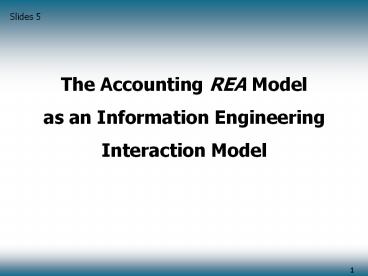The Accounting REA Model - PowerPoint PPT Presentation
Title:
The Accounting REA Model
Description:
Slides 5 The Accounting REA Model as an Information Engineering Interaction Model Review of Modeling A model is a representation of reality Systems analysts seek to ... – PowerPoint PPT presentation
Number of Views:563
Avg rating:3.0/5.0
Title: The Accounting REA Model
1
Slides 5
The Accounting REA Model as an Information
Engineering Interaction Model
2
Review of Modeling
- A model is a representation of reality
- Systems analysts seek to understand an
organization by building a representation of the
business and its workings, called a business
model (also conceptual or logical model) - An IE business model includes three primary types
of models (1) data models, (2) activity models,
and (3) interaction models
3
Analysis Tasks with REA Interaction Modeling
AHD, ADD
Activity Analysis
REA
Preliminary Interaction Analysis 1
PLD, ELC
ERD
Formal Interaction Analysis 2
Systems Design Planning
Data Analysis
4
Types of Models
- Activity models Record the activities of
interest to the business (i.e., the things the
business does or should do). - Involves decomposition of business processes from
the highest level (AMP of Resources, Conversion
Processes, MSC Processes) to the lowest
(elementary processes) - template - Also involves the specification of process
dependency events, to refine decomposition of the
processes.
5
Activity Models Template for Decomposition of
Business Processes (IPSO) - REPEAT
Adds value
RBMS
Source Hollander, Denna Cherrington (2000),
adapted
6
Business Processes
AMP Processes
Conversion Processes
MSCProcesses
Human Resources Financial Resources Supplies Inven
tories Property, Plant and Equipment
Operations Varies widely depending upon the
industry
Marketing Sales Collection and Credit
7
Activity Model Business Function Decomposition
8
Types of Models
- Interaction models Define how things the
business does (activities/events) affect things
of interest to the business (data) - The REA model is an interaction model
- We have combined the IE notation of an
interaction model with the accounting REA(L) model
9
Source Hollander, Denna Cherrington, 1996
10
- REAL modeling is an aid in analyzing an
organization and its activities (helps develop
activity models by identifying lowest level of
decomposition) - Helps decide what data to collect (helps develop
data models) - Enhances your ability to evaluate business
processes and identify processes and events that
are not valuable, not competitive, and/or not
meeting the objectives of the organization
11
Process and Events
Take customer order
Ship goods
Business Process Simple MS
12
REA Template With Two Events
Internal Agent
Location
Event 1 Take customer order
External Agent
Resource
Internal Agent
Location
Event 2 Ship goods
External Agent
Resource
13
Validate The REAL Model With Business
Persons
- Those who understand the details and objectives
of the business process and events being modeled
should perform the validation. - Validation sessions should result in either the
confirmation of the models accuracy or
modification of the model.
14
Relationships
- Data modeling term that indicates an association
between tables How the things of significance
are related (A FK must match to an existing PK,
or else be NULL) - This controlled redundancy allows linking of
tables (hence relational) - Entity-Relationship Diagram (ERD) A data model
(at the conceptual level) that shows the
relationships enforcing business rules between
entities (tables) in a database environment
15
Connectivity or Cardinality
- One-to-One (PK ---gt PK) - Generally indicates
that your data model has two entity types that
can be collapsed into one - One-to-Many (PK ---gt FK) - Most common
- Many-to-Many (FK ---gt FK) - Not enforceable by
RDMS generally indicates that a modeling error
has occurred - this type of relationship means
that your model is missing an entity type
16
Cardinality of Relationships
- Mandatory - an instance of an entity in one table
does require a associated record in another table
(as defined by a relationship) - Optional - an instance of an entity in one table
does not require a associated record in a another
table (as defined by a relationship)
17
Different Notations to Represent Relationships
Cardinalities (could even be on opposite sides of
the connecting line a mirror image) - handout
(1,1)
(1,N)
(0,1)
(0,N)
18
Events
- Most events are easy to identify because the
business records data on forms or files. - Events are characterized by the fact that they
happen or have duration - For activity and REAL models, they are
characterized by at least a verb and a noun, but
could have an adjective, take customer order,
deliver customer order, pay supplier - For data models (converting REAL to ERD), they
are characterized by a noun, e.g., Order header,
Order detail, Sales header, Sales detail, Cash
receipt
19
A REAL Interaction Model for MSC Function
Note Use of verb/noun
20
Surrounding RALs
- AGENTS
- Entity types that describe roles played in a
system. They usually represent people or
organizations. - APPLICANT, BORROWER, CLIENT, CREDITOR, EMPLOYEE,
EMPLOYER, INSTRUCTOR, MANAGER, SALESPERSON, VENDOR
21
Surrounding RALS
- RESOURCES
- Entity types that describe tangible things.
- EQUIPMENT, INVENTORY, CASH, MACHINE, MATERIAL,
PART, PRODUCT, VEHICLE, but they can also be
Informational Resources, e.g., PRODUCT CATALOG
22
Surrounding RALs
- LOCATIONS
- Entity types that describe locations
- BRANCH, BUILDING, CAMPUS, CITY, COUNTRY, COUNTY,
SALES REGION, WAREHOUSE, STORE, FRANCHISEE
23
Data model ERD with Normalization































